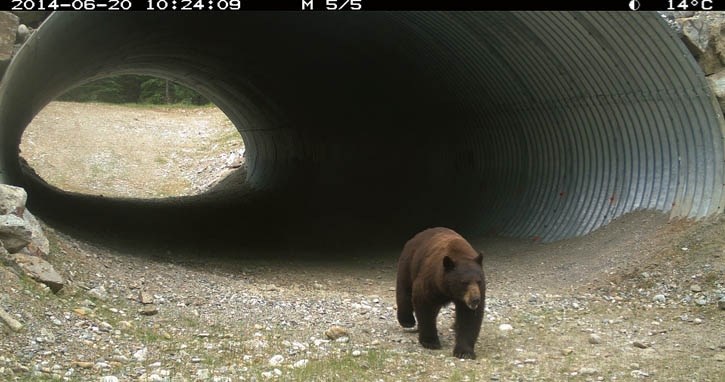For the first time, a black bear has travelled through one of the new underpasses in Kootenay National Park.
Parks Canada’s wildlife cameras recorded a large, brown-coloured black bear using one of three new wildlife underpasses on June 20, but it wasn’t until researchers were going through camera images this fall that the first bear crossing was discovered.
“The list of species that has been using the underpasses continues to grow and now we have had the first black bear in the first year since they were built,” said Trevor Kinley, road ecologist for Lake Louise, Yoho and Kootenay.
“Whenever you build these things you keep your fingers crossed and it does normally take a few years to get them (bears) used to using them … they’re often hesitant at first.”
Presently, there are three underpasses and 4.7 kilometres of wildlife fencing in the Dolly Varden day-use area on Highway 93 South, about 35 km from the southern end of the park. They were completed about a year ago at a cost of $4 million.
Parks Canada plans to build at least four more wildlife crossing structures and another 6.5-km of fencing further north towards Kootenay Crossing. The price tag for this second phase is $9.6 million.
More than 5,000 vehicles travel Highway 93 South on a typical summer day, and statistics show that more than 500 animals have been killed on this highway in the last decade. The busy road is a barrier to wildlife searching for food, shelter and mates.
The most commonly killed animals are whitetailed deer, an important prey species for wolves and cougar. They account for more than 70 per cent of mortalities. The road toll also includes wolves, grizzly bears, black bears, moose, lynx, wolverine and bighorn sheep.
Collisions with wildlife also cost money – for emergency response, hospital care, vehicle repairs, loss of wildlife, and dealing with dead or injured animals. These costs were recently estimated by Parks Canada at $6,600 per deer, $17,000 per elk, and $30,000 per moose.
Kinley said that four minutes before the black bear was recorded using the underpass on June 20, a camera picked up an image of the rear of a different black bear walking parallel to the fence.
He said the bear did not approach or go through the underpass.
“The timing was interesting to us because June 20 is right near the peak of black bear breeding,” said Kinley.
“Given that it would be unusual to have two big black bears in the same place, same time – it’s not a concentrated area for black bears – we suspect it was probably a female he was attracted to or another male trying to push off.”
The new underpasses are used almost daily by whitetail deer. There has also been use by wolves, a moose, mule deer and snowshoe hare.




